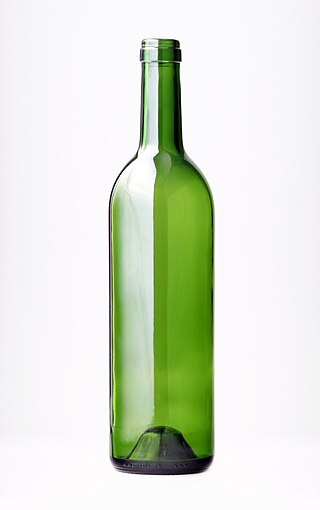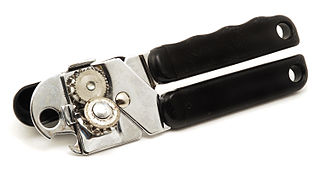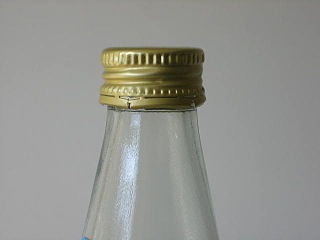
Cork is an impermeable buoyant material. It is the phellem layer of bark tissue which is harvested for commercial use primarily from Quercus suber, which is native to southwest Europe and northwest Africa. Cork is composed of suberin, a hydrophobic substance. Because of its impermeable, buoyant, elastic, and fire retardant properties, it is used in a variety of products, the most common of which is wine stoppers.

A cock ring is a ring worn around the penis, usually at the base. The primary purpose of wearing a cock ring is to restrict the flow of blood from the erect penis to produce a stronger erection or to maintain an erection for a longer period of time. They are sometimes used as medical devices, on their own or in conjunction with a penis pump to assist in the management of erectile dysfunction. Genital adornment is another purpose, as is repositioning the genitals to provide an enhanced appearance.

A bottle is a narrow-necked container made of an impermeable material in various shapes and sizes that stores and transports liquids. Its mouth, at the bottling line, can be sealed with an internal stopper, an external bottle cap, a closure, or induction sealing.

A drink can is a metal container designed to hold a fixed portion of liquid such as carbonated soft drinks, alcoholic drinks, fruit juices, teas, herbal teas, energy drinks, etc. Drink cans are made of aluminum or tin-plated steel. Worldwide production for all drink cans is approximately 370 billion cans per year.

A bottle cap or bottle top is a closure for the top opening of a bottle. A cap is sometimes colorfully decorated with the logo of the brand of contents. Plastic caps are used for plastic bottles, while metal with plastic backing is used for glass; plastic caps are commonly made from polyethylene or polypropylene, while metal caps are usually either steel or aluminum. Plastic caps may have a pour spout. Flip-Top caps like Flapper closures provide controlled dispensing of dry products. Caps for plastic bottles are often made of a different type of plastic from the bottle.

A steel can, tin can, tin, or can is a container made of thin metal, for distribution or storage of goods. Some cans are opened by removing the top panel with a can opener or other tool; others have covers removable by hand without a tool. Cans can store a broad variety of contents: food, beverages, oil, chemicals, etc.

A can opener or tin opener is a mechanical device used to open metal tin cans. Although preservation of food using tin cans had been practiced since at least 1772 in the Netherlands, the first can openers were not patented until 1855 in England and 1858 in the United States. These early openers were basically variations of a knife, though the 1855 design continues to be produced.

Kings is a drinking game using playing cards. Players must drink and dispense drinks based on cards drawn. The cards have predetermined drink rules prior to the game's beginning. Often groups establish house rules with their own game variations.

A beer bottle is a bottle designed as a container for beer. Such designs vary greatly in size and shape, but the glass commonly is brown or green to reduce spoilage from light, especially ultraviolet.

A beverage-can stove, or pop-can stove, is a do it yourself, ultralight, alcohol-burning portable stove. It is made using parts from two aluminium beverage cans. Basic designs can be relatively simple, but many variations exist.

A bottle opener is a device that enables the removal of metal bottle caps from glass bottles. More generally, it might be thought to include corkscrews used to remove cork or plastic stoppers from wine bottles.

A closure is a device used to close or seal a container such as a bottle, jug, jar, tube, or can. A closure may be a cap, cover, lid, plug, liner, or the like. The part of the container to which the closure is applied is called the finish.

A Mason jar, also known as a canning jar, preserves jar or fruit jar, is a glass jar used in home canning to preserve food. It was named after American tinsmith John Landis Mason, who patented it in 1858. The jar's mouth has a screw thread on its outer perimeter to accept a metal ring or "band". The band, when screwed down, presses a separate stamped steel disc-shaped lid against the jar's rim.
Crown Holdings, Inc., formerly Crown Cork & Seal Company, is an American company that makes metal beverage and food cans, metal aerosol containers, metal closures and specialty packing. Founded in 1892, it is headquartered in Yardley, Pennsylvania. As of their annual report for 2020, Crown employs 33,264 people at 192 plants in 39 countries. It claims to manufacture one out of every five beverage cans used in the world, and one out of every three food cans used in North America and Europe. The company is ranked No. 286 in the Fortune 500 list for 2022 and is number one in the packaging and container industry for the same list.

Wine corks are a stopper used to seal wine bottles. They are typically made from cork, though synthetic materials can be used. Common alternative wine closures include screw caps and glass stoppers. 68 percent of all cork is produced for wine bottle stoppers.

A tamper-evident band or security ring serves as a tamper resistant or tamper evident function to a screw cap, lid, or closure. The term tamper-proof is sometimes used but is considered a misnomer given that pilfering is still technically possible.

A screw cap is a metal, normally aluminium, cap that screws onto threads on the neck of a wine bottle, generally with a metal skirt down the neck to resemble the traditional wine capsule ("foil"). A layer of plastic, cork, rubber, or other soft material is used as wad to make a seal with the mouth of the bottle. Its use as an alternative to cork for sealing wine bottles is gaining increasing support. In markets such as Australia and New Zealand screw caps on bottles have overtaken cork to become the most common means of sealing bottles.

A flip-top, swing-top, lightning toggle, or Quillfeldt stopper is a type of bail closure frequently used for bottles containing carbonated beverages, such as beer or mineral water. The mouth of the bottle is sealed by a stopper, usually made of porcelain or plastic, fitted with a rubber gasket and held in place by a permanently attached wire bail. The bottle can be opened and resealed repeatedly without the use of a bottle opener, with the wires acting in the same way as a latch clamp. The flip-top was the dominant method of sealing beer and mineral water bottles prior to the invention of the crown cork

A mounted or bar corkscrew is a device screwed or clamped to a wall or counter top, used to draw corks from beer, wine or other bottles.

Anthony Dominic Bajada was a British–American inventor known for creating and patenting the stay-tab press-to-open lid mechanism for drink cans.





















